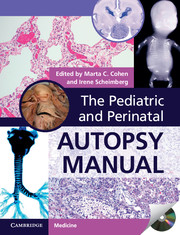Book contents
- Frontmatter
- Contents
- List of contributors
- Foreword
- Preface
- Acknowledgments
- 1 Perinatal autopsy, techniques, and classifications
- 2 Placental examination
- 3 The fetus less than 15 weeks gestation
- 4 Stillbirth and intrauterine growth restriction
- 5 Hydrops fetalis
- 6 Pathology of twinning and higher multiple pregnancy
- 7 Is this a syndrome? Patterns in genetic conditions
- 8 The metabolic disease autopsy
- 9 The abnormal heart
- 10 Central nervous system
- 11 Significant congenital abnormalities of the respiratory, digestive, and renal systems
- 12 Skeletal dysplasias
- 13 Congenital tumors
- 14 Complications of prematurity
- 15 Intrapartum and neonatal death
- 16 Sudden unexpected death in infancy
- 17 Infections and malnutrition
- 18 Role of MRI and radiology in post mortems
- 19 The forensic post mortem
- 20 Appendix tables
- Index
12 - Skeletal dysplasias
Published online by Cambridge University Press: 05 September 2014
- Frontmatter
- Contents
- List of contributors
- Foreword
- Preface
- Acknowledgments
- 1 Perinatal autopsy, techniques, and classifications
- 2 Placental examination
- 3 The fetus less than 15 weeks gestation
- 4 Stillbirth and intrauterine growth restriction
- 5 Hydrops fetalis
- 6 Pathology of twinning and higher multiple pregnancy
- 7 Is this a syndrome? Patterns in genetic conditions
- 8 The metabolic disease autopsy
- 9 The abnormal heart
- 10 Central nervous system
- 11 Significant congenital abnormalities of the respiratory, digestive, and renal systems
- 12 Skeletal dysplasias
- 13 Congenital tumors
- 14 Complications of prematurity
- 15 Intrapartum and neonatal death
- 16 Sudden unexpected death in infancy
- 17 Infections and malnutrition
- 18 Role of MRI and radiology in post mortems
- 19 The forensic post mortem
- 20 Appendix tables
- Index
Summary
Introduction
Skeletal dysplasias are disorders of cartilage and/or bones that affect their growth, shape, and integrity [1–9]. Skeletal dysplasias are part of a large group of genetic skeletal disorders that refer to abnormal skeletal development on the basis of a defective genetic background. The genetic skeletal disorders, although individually rare, are not uncommon as a whole group. The 2010 Revision of the Nosology and Classification of Genetic Skeletal Disorders [7] includes 456 entities. At least 50 of these are lethal in the perinatal period, often due to lung hypoplasia.
Skeletal dysplasias or osteochondrodysplasias affect the long bones in a generalized manner with or without involvement of the membranous bone of the skull. The abnormalities are usually symmetric. Dwarfism is common and often disproportionate.
Prenatal ultrasound can detect several skeletal dysplasias and there are sonographic measurements that serve as good predictors of lethality. However, the correct typing of each skeletal dysplasia is still dependent on the autopsy and/or molecular genetics.
Skeletal dysplasias can be daunting. Nevertheless, a systematic autopsy approach can collect and assimilate all the pieces of the puzzle to properly categorize each suspected skeletal dysplasia case.
Handling fetuses/babies suspected of a skeletal dysplasia needs a team effort, but the pathologist is the one tasked with collecting the crucial pieces of the puzzle for the team to study and assimilate to help the parents.
First, the basic autopsy approach will be outlined and illustrated. Second, examples of the four most common types of lethal skeletal dysplasias will be given. Third, uncommon types of lethal skeletal dysplasias will be described. Fourth, examples of syndromes/complexes with limb involvement that can often be confused with lethal skeletal dysplasias will be given.
- Type
- Chapter
- Information
- The Pediatric and Perinatal Autopsy Manual , pp. 235 - 261Publisher: Cambridge University PressPrint publication year: 2000
- 1
- Cited by



